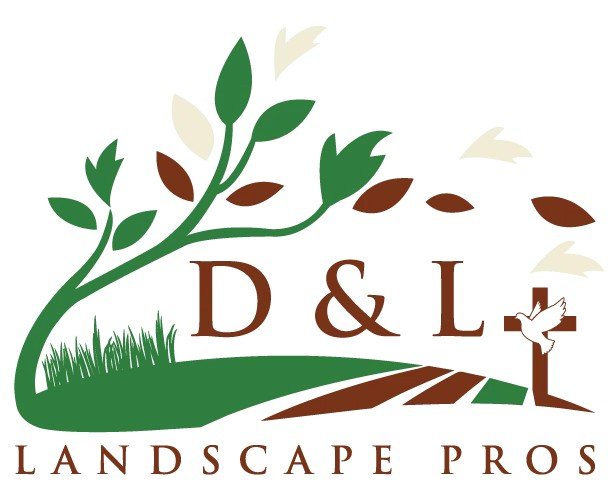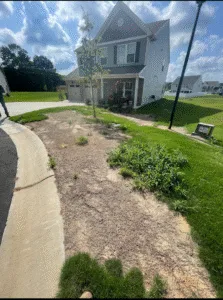
Winter in North Carolina can be harsh on your lawn. While the cold here is milder than in northern states, foot traffic and frost can still cause significant damage to grass, leading to brown patches, soil compaction, and stressed roots. For homeowners in South Charlotte, Matthews, Waxhaw, and Indian Trail, understanding how to protect your lawn during winter is key to having a vibrant, healthy yard come spring.
At D & L Landscape Pros, we specialize in lawn care and maintenance that keeps your grass looking its best year-round. In this guide, we’ll cover the causes of winter lawn damage, practical prevention strategies, and professional tips to ensure your lawn thrives even through the coldest months.
Why Winter Lawn Damage Happens
Even in mild winters, several factors can negatively impact your grass:
- Foot Traffic
- Walking on frozen or dormant grass can crush blades and damage roots.
- Heavy equipment or pets can worsen the problem, especially if the soil is wet or frozen.
- Walking on frozen or dormant grass can crush blades and damage roots.
- Frost
- Frost occurs when the temperature drops below freezing and water in grass blades crystallizes.
- Walking on frosted grass can tear blades and bruise the crown of the plant, which stores essential nutrients.
- Frost occurs when the temperature drops below freezing and water in grass blades crystallizes.
- Soil Compaction
- Frozen ground combined with regular foot traffic compresses the soil, making it harder for roots to absorb nutrients and water.
- Frozen ground combined with regular foot traffic compresses the soil, making it harder for roots to absorb nutrients and water.
- Stress from Environmental Conditions
- Cold temperatures slow down growth and reduce the grass’s ability to recover from damage.
- Cold temperatures slow down growth and reduce the grass’s ability to recover from damage.
The combination of these factors can leave lawns looking brown, patchy, and weakened in spring if preventative measures are not taken.
Choosing the Right Grass for NC Winters
The type of grass you have plays a significant role in winter resilience. In North Carolina, lawns are typically a mix of:
- Cool-season grasses (like fescue or Kentucky bluegrass)
- Grow actively in spring and fall; go dormant in winter but recover quickly in spring.
- Grow actively in spring and fall; go dormant in winter but recover quickly in spring.
- Warm-season grasses (like Bermuda or Zoysia)
- Grow actively in summer; go dormant in winter and appear brown, but the root system remains healthy.
- Grow actively in summer; go dormant in winter and appear brown, but the root system remains healthy.
Knowing your grass type helps determine the best strategies for protecting it during cold weather and reducing foot traffic damage.
Practical Tips to Prevent Winter Lawn Damage
1. Minimize Foot Traffic on Frosty Grass
- Avoid walking on frozen or wet grass as much as possible.
- Create alternative pathways using mulch, stepping stones, or gravel.
- Encourage pets to stay off vulnerable areas or direct them to specific spots.
2. Aerate and Fertilize in Fall
- Aeration relieves soil compaction, allowing water and nutrients to reach roots.
- Fall fertilization strengthens grass before winter by promoting root growth and nutrient storage.
- Both practices reduce stress from winter foot traffic and improve recovery in spring.
3. Keep Grass at Optimal Height
- Before winter, mow your lawn slightly higher than summer height for added insulation.
- Longer grass blades help protect the soil and crown from frost damage.
- Avoid scalping the lawn, as short grass is more vulnerable to freezing and wear.
4. Control Traffic Areas
- Identify high-traffic zones like pathways to sheds, garages, or mailboxes.
- Install temporary barriers, mulch walkways, or pavers to prevent repeated foot traffic.
- Rotating walking paths reduces stress on a single area.
5. Water Wisely
- Even in winter, dormant grass can benefit from occasional watering during dry periods.
- Avoid overwatering, which can freeze and create icy patches that increase damage risk.
6. Protect Lawns from Pets and Equipment
- Dogs running on frozen lawns can tear grass and soil.
- Heavy lawn equipment stored or used on frozen ground can cause compaction.
- Direct pets to mulch or gravel areas and avoid using machinery on frozen lawns.
7. Repair Early Damage
- Inspect your lawn periodically for bruised or flattened areas.
- Loosen soil gently in damaged spots and add a thin layer of topsoil or compost.
- Overseed early in spring to fill in damaged areas and promote recovery.
Professional Lawn Care Strategies
Homeowners in South Charlotte, Matthews, Waxhaw, and Indian Trail often find professional services make winter lawn protection easier and more effective. Here’s what a team like D & L Landscape Pros can do:
1. Pre-Winter Lawn Assessment
- Evaluate soil, grass type, and problem areas.
- Recommend fertilization, aeration, or overseeding to strengthen the lawn before frost hits.
2. Aeration and Overseeding Services
- Proper aeration reduces compaction from winter foot traffic.
- Overseeding adds density, helping grass recover quickly after stress or frost damage.
3. Seasonal Fertilization
- Fall and late-season fertilizers boost root growth and nutrient storage.
- Grass is better equipped to survive winter stress and spring recovery.
4. Mulching and Yard Protection
- Mulching beds and lawn edges helps insulate soil and reduces frost impact.
- Expert guidance on temporary protective coverings for high-traffic zones.
5. Post-Winter Recovery Plans
- Inspect the lawn after thawing for frost damage or compaction issues.
- Provide targeted treatments like aeration, reseeding, or fertilization for optimal recovery.
Common Mistakes Homeowners Make
Even with the best intentions, many homeowners unintentionally damage their lawns during winter:
- Walking on Frosted Grass – Damages blades and crowns.
- Neglecting Fall Maintenance – Skipping aeration, fertilization, or leaf cleanup weakens grass.
- Overwatering or Underwatering – Both can stress dormant grass and make it susceptible to damage.
- Ignoring Soil Compaction – Frozen, compacted soil prevents root growth and recovery.
- Delayed Repair – Waiting too long to fix damaged spots allows weeds or bare patches to take over.
Avoiding these mistakes ensures your lawn survives winter intact and returns green and healthy in spring.
Benefits of Hiring D & L Landscape Pros
Working with a professional lawn care team takes the guesswork out of winter lawn protection. Here’s why homeowners in South Charlotte, Matthews, Waxhaw, and Indian Trail trust us:
- Expert Knowledge – We understand NC climate, frost patterns, and local grass types.
- Customized Care Plans – Tailored aeration, fertilization, and protection strategies for your yard.
- Equipment and Techniques – Access to professional tools that minimize compaction and damage.
- Year-Round Support – We don’t just protect your lawn in winter — we prepare it for spring growth.
Our goal is to keep your lawn looking lush, healthy, and beautiful no matter the season.
Final Thoughts
Winter doesn’t have to be a season of stress for your lawn. By taking steps to minimize foot traffic, prevent frost damage, and strengthen grass through fall maintenance, you can enjoy a lawn that bounces back quickly in spring.
Key takeaways:
- Limit walking on frozen or wet grass.
- Aerate, fertilize, and overseed in fall to prepare for winter stress.
- Maintain proper grass height and watering practices.
- Protect high-traffic areas and repair early damage promptly.
If you want a professionally maintained lawn that survives winter and looks amazing in spring, D & L Landscape Pros is here to help. We provide expert winter lawn protection, seasonal maintenance, and recovery services for homeowners in South Charlotte, Matthews, Waxhaw, and Indian Trail.📞 Call us today to schedule a consultation and protect your lawn from winter foot traffic and frost damage. Your grass will thank you when spring arrives!




